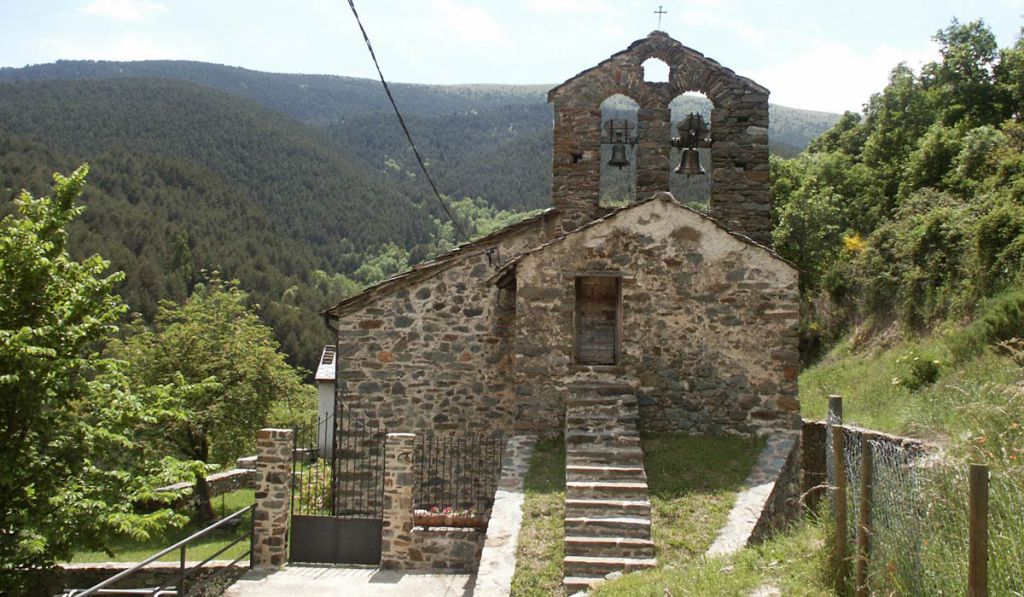The Romanesque represents one of the greatest moments of the history of Catalan art both because of the crucial importance of some monuments, internationally recognized, and also because of the fact that in the history and in the imaginary of Catalonia it has almost mystical connotations associated with the political and national origins of the county. The concepts of Catalonia and Catalan became popular during the 11th and 12th centuries, when the first Catalan writings began to be produced. As for art, these centuries constitute the so-called Romanesque.

Fornells
Campelles
Church of St. Martí: Former Romanesque church that was demolished by a French invasion and rebuilt and enlarged at the end of the 18th century,.
Pardines
Church of St. Esteve: There are few remains of the original Romanesque building. You can only see an apse, narrower than the nave, which was converted into a defence tower in the 14th century.Queden poques restes de l’edifici original romànic. Tan sols podem observar un absis, més estret que la nau, que al segle XIV fou convertit en la base d’una torre de defensa.
Church of St. Magdalena de Puigsac: Original building from the 12th century.
Planoles
Church of St. Marcel de Planès: Dated back in the 11th century, this church is formed by a unique rectangular nave, covered by a barrel vault and reinforced by a horseshoe-shaped apse inside and semi-circular outside. It has a belfry. This small church is a typical example of the Romanesque rural architecture.
Church of St. Vicenç de Planoles: It belongs to the Lombard architecture of the 11th century, although due to its rusticity it could be dated to the 12th century. Nowadays, there is a small porch atrium. As for the tower’s belfry, it was built in the 19th century, breaking out the style of the rest of the complex.
Queralbs
Church of St. Jaume: Romanesque church from the 12th century. It stands out for its porch, made up by six arches that rest on five blue marble columns. It is one of the best examples of the well-preserved Romanesque Catalan porches until today. During the fifteenth and seventeenth centuries, the original building suffered some modifications such as the enlargement of the central nave with two square chapels; the construction of the vestry with chapel and the building of a tower belfry crowned by a small bell gable.
Fustanyà
Church of St. Sadurní de Fustanyà: In the southern façade, there is the entrance door that stands out for its decoration and distribution of the ironwork, quite common in the 11th and 12th centuries. Remnants of a medieval graveyard and ceramic fragments such as the small black clay pot with mouth were found next to a tomb. They probably date from the end of the 11thcentury or beginning of the 12th century.
Serrat
Church of Mare de Déu del Remei del Serrat: It dates from the 12th century.
Ribes de Freser
Church of St. Mary: The original Romanesque church was demolished in 1936 and it was replaced by a modern temple designed by Josep Danés. Inside the building, there is a reproduction of the famous Baldachin of Ribes, one of the best panel paintings of the Catalan 12th century. From the original Romanesque church only three apses are preserved and they are used as side chapels.
St. Pere Castle: it is a structure known as “the tower”, which is the tallest and best preserved part of the castle. It has a minimum of three visible floors, some windows and loopholes.
Segura Castle: dated from the 13th century, there is still part of the eastern wall, a piece of the northern end walls and a big cistern protected by a large carved stone. Inside the castle, the barrel vault roof and the original plaster or stucco walls are still visible.
Ventolà
Church of Sant Cristòfol de Ventolà: The earliest references date from the 12th century. The belfry, with pointed windows, was built later. It has been recently restored and a modern porch with an old structure added.
Bruguera
Church of Sant Feliu de Bruguera: Dated from the 12th century, it suffered a big transformation in the 18th century. From the original church, only a part of the apse without decoration and a part of the belfry are still preserved. Although it is bricked up, the arched portal is still visible.
Batet
Chapel of Verge del Carme: It is restored.
Toses i Dòrria
Church of St. Cristòfol de Toses: Magnificent Romanesque edifice from the 11th century. The most notable elements of the complex are the ornamental ironwork of the door, the decorated belfry with Lombard arching and the Romanesque inside paintings. A reproduction of the original works can be seen in the MNAC (Catalonia National Art Museum).
Church of St. Víctor de Dòrria: In November 1997, due to a restoration project in the church, some Romanesque mural paintings were discovered. These original frescos are from the 12th century and they are the only ones you can find in the Ripollès area.
Source: Tourist Office Vall de Ribes
